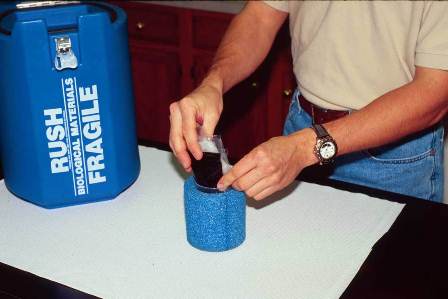 The advent of transported cooled semen significantly altered the logistics of the equine breeding industry. Shipping semen to mares rather than mares to stallions is incredibly more convenient; however it has resulted in the need for increased proficiency in semen processing techniques on the part of the stallion manager and expertise in reproductive technology and artificial insemination on the part of the field practitioner managing the mare. From the perspective of the stallion manager there are a number of factors that can influence the success of cooled transported semen such as stallion collection management, semen handling, extender composition, dilution rate, cooling rate, calculation of insemination dose and transport device. Our blog article this month will address the basic techniques for proper collection, evaluation and processing of stallion semen for cooled transport.
The advent of transported cooled semen significantly altered the logistics of the equine breeding industry. Shipping semen to mares rather than mares to stallions is incredibly more convenient; however it has resulted in the need for increased proficiency in semen processing techniques on the part of the stallion manager and expertise in reproductive technology and artificial insemination on the part of the field practitioner managing the mare. From the perspective of the stallion manager there are a number of factors that can influence the success of cooled transported semen such as stallion collection management, semen handling, extender composition, dilution rate, cooling rate, calculation of insemination dose and transport device. Our blog article this month will address the basic techniques for proper collection, evaluation and processing of stallion semen for cooled transport.
Start with a Good Sample
The first critical aspect of a successful semen preservation technique is to obtain a high quality sample without damaging the fragile sperm during collection or processing. This may seem obvious and simple yet in our work with breeding farms and clinics we find that this is where many of the problems occur. The ideal sample for semen preservation (either cooling or freezing) is one that contains a high concentration of sperm and therefore a low ratio of seminal plasma and exhibits a high percentage of progressively motile sperm with a low percentage of morphological abnormalities. This can be accomplished by managing the collection frequency for the stallion such that the number of days sexual rest prior to collection is optimum to obtain an ejaculate with the desired characteristics as well as limiting the amount of sexual stimulation prior to collection. Ideally, the stallion should be stimulated just enough to elicit a good erection and result in ejaculation obtained on a single mount. Another management tool that we find very useful is to “void” as much of the pre-ejaculatory fluid as possible prior to placing the stallion’s penis into the AV for collection. This fluid contains no sperm and only serves to dilute out the sperm in the collected semen with fluid that is far from an ideal media for incubating sperm.
Sperm can suffer sub-lethal damage from many sources and this damage may not be obvious during initial evaluation but only be revealed after the sperm are stored for a period of time as is the case when transporting cooled semen. Factors that can adversely affect sperm motility include:
1. Toxic residues on collection equipment such as soap residues and minerals in tap water. To avoid this it is recommended that whenever possible disposable AV liners and semen containers be used and if latex reusable liners are used they are cleaned and rinsed thoroughly with deionized water to remove residues.
2. Contamination of semen with high osmolarity, water soluble lubricants. This can be avoided by use of water soluble lubricants osmotically balanced with semen, use of minimum quantities of lubricant in the AV and changing the semen collection container after each unsuccessful mount when multiple mounts are required to obtain an ejaculation.
3. Temperature shock caused by exposing the semen to either too high or too low temperatures. Ejaculated spermatozoa are very sensitive to cold and heat shock and every precaution should be taken to avoid temperature deviations from the optimal range of 34-37C prior to diluting the semen in extender. Once extended, sperm should not be incubated at 37C as prolonged incubation at this temperature will reduce sperm motility.
4. Excessive bacterial contamination. It is essential that good hygiene be practiced when obtaining samples to avoid contamination with bacteria from inadequately cleaned collection equipment including the AV, phantom, wash bucket, etc.
Sperm Count
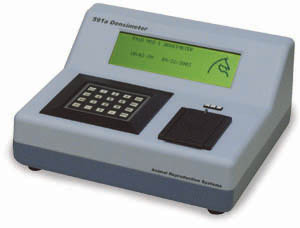 Once collected, semen must be evaluated to determine sperm concentration and motility. In order to dilute semen properly, an accurate measurement of sperm concentration is required. Sperm concentration can vary widely between ejaculates depending on collection frequency and pre-collection stimulation and therefore must be measured on each ejaculate. Most laboratories use some type of photometer to measure sperm concentration. For all photometers, the displayed concentration is actually inferred from the amount of light blocked in a sample of semen diluted in a known volume of a clear diluent such as formalin. The greater the sperm concentration, the more light is blocked and the measurement of transmitted light is compared to a standard curve for light absorption that has been created from actual hemacytometer counts of sperm. These instruments are rapid and easy to use however they do require careful attention to dilution technique and they are generally less accurate at concentrations that are out of the normal range of 100 to 300 million sperm/ml. Direct counting with a hemacytometer is accurate but only if done properly and only if an adequate number of chambers (minimum of 4) is counted. This is very time consuming and impractical for most busy breeding laboratories. A relatively new automated direct counting technology (Chemometec Nucleocounter SP-100) that utilizes a fluorescent DNA stain provides a very accurate, rapid determination of sperm concentration on a large number of cells however the cost is considerably higher than most photometers.
Once collected, semen must be evaluated to determine sperm concentration and motility. In order to dilute semen properly, an accurate measurement of sperm concentration is required. Sperm concentration can vary widely between ejaculates depending on collection frequency and pre-collection stimulation and therefore must be measured on each ejaculate. Most laboratories use some type of photometer to measure sperm concentration. For all photometers, the displayed concentration is actually inferred from the amount of light blocked in a sample of semen diluted in a known volume of a clear diluent such as formalin. The greater the sperm concentration, the more light is blocked and the measurement of transmitted light is compared to a standard curve for light absorption that has been created from actual hemacytometer counts of sperm. These instruments are rapid and easy to use however they do require careful attention to dilution technique and they are generally less accurate at concentrations that are out of the normal range of 100 to 300 million sperm/ml. Direct counting with a hemacytometer is accurate but only if done properly and only if an adequate number of chambers (minimum of 4) is counted. This is very time consuming and impractical for most busy breeding laboratories. A relatively new automated direct counting technology (Chemometec Nucleocounter SP-100) that utilizes a fluorescent DNA stain provides a very accurate, rapid determination of sperm concentration on a large number of cells however the cost is considerably higher than most photometers.
Analysis of Sperm Motility
Sperm motility is a convenient measurement of relative cell health and the most commonly used indicator of semen quality. Sperm motility can be estimated by a trained technician using a subjective visual method that requires a good quality (preferably phase-contrast) microscope with a heated stage. Alternatively, a more accurate and objective computer assisted sperm motility analyzer (CASA) can be used to determine percent motility as well as velocity and numerous other motion characteristics.
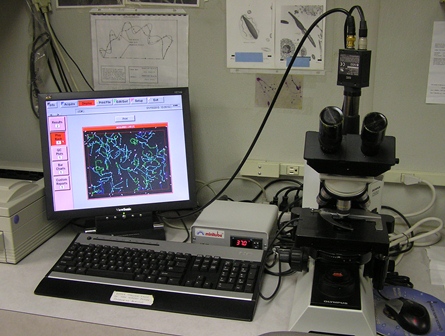 It is recommended that each breeding dose contain a minimum of 500 million progressively motile sperm at 24hr. In order to calculate how many sperm should be packaged into a breeding dose to fulfill this industry accepted minimum requirement, the average progressive motility at 24hrs of storage at 5°C for the stallion must be known. Therefore the longevity of sperm motility at 5°C should be determined for each stallion. At a minimum this may be performed as part of a breeding evaluation at the start of each breeding season. Alternatively we routinely keep a “test” dose or sample of extended semen, stored in a shipping container at 5°C in the lab, whenever we send out a shipment. That way we can monitor the motility at 24 and 48hrs after collection throughout the breeding season. Consequently we are aware of and prepared to manage any changes in semen quality immediately. In addition, if a concern is raised regarding the semen quality of a particular shipment, we have a reference sample in the lab to compare to. Knowing the longevity of motility for a stallion in a cooled semen program can also influence decisions about how many doses to ship and what method of shipment is best suited to a particular stallion. For example, if semen from a stallion does not maintain adequate motility beyond 18-24hrs, it may be preferable to offer same day counter-to-counter airline shipments as opposed to overnight shipping. If adequate sperm motility is not maintained beyond 12hrs, it may be preferable to discontinue shipped semen and breed mares on farm only. Ideally the minimum progressive motility of an extended semen sample shipped in a commercial cooled semen program should be 30% at 24hrs of storage at 5°C.
It is recommended that each breeding dose contain a minimum of 500 million progressively motile sperm at 24hr. In order to calculate how many sperm should be packaged into a breeding dose to fulfill this industry accepted minimum requirement, the average progressive motility at 24hrs of storage at 5°C for the stallion must be known. Therefore the longevity of sperm motility at 5°C should be determined for each stallion. At a minimum this may be performed as part of a breeding evaluation at the start of each breeding season. Alternatively we routinely keep a “test” dose or sample of extended semen, stored in a shipping container at 5°C in the lab, whenever we send out a shipment. That way we can monitor the motility at 24 and 48hrs after collection throughout the breeding season. Consequently we are aware of and prepared to manage any changes in semen quality immediately. In addition, if a concern is raised regarding the semen quality of a particular shipment, we have a reference sample in the lab to compare to. Knowing the longevity of motility for a stallion in a cooled semen program can also influence decisions about how many doses to ship and what method of shipment is best suited to a particular stallion. For example, if semen from a stallion does not maintain adequate motility beyond 18-24hrs, it may be preferable to offer same day counter-to-counter airline shipments as opposed to overnight shipping. If adequate sperm motility is not maintained beyond 12hrs, it may be preferable to discontinue shipped semen and breed mares on farm only. Ideally the minimum progressive motility of an extended semen sample shipped in a commercial cooled semen program should be 30% at 24hrs of storage at 5°C.
Other sperm quality assays exist but are not routinely used by most laboratories when processing semen for cooled transport. The success of a cooled transported semen program will depend upon the inherent fertility of the stallion and mares involved, the inherent ability of spermatozoa from an individual stallion to withstand the stresses of cooling and several semen processing factors. Those factors that will most affect the quality of cooled transported semen include; extender type, dilution rate, cooling rate, transport container, storage temperature, storage time and insemination dose.
Extenders
Although numerous commercial extenders are available for diluting stallion semen for cooling, the majority of them are skim milk – sugar based with the most commonly used being a skim milk – glucose based extender known as the Kenney extender, named for its developer Dr. Bob Kenney. This extender along with slight variations of the original formula is used by many laboratories processing cooled semen today and is available under numerous commercial brands. Variations on the original formula include: addition of sugars such as sucrose or lactose, changing antibiotics and inclusion of buffers against pH change.
More recently extenders that contain defined milk protein rather than complete milk powder have been introduced for diluting and cooling equine semen. These extenders were developed to allow for a more chemically defined media that contains only the native phosphocasienates from milk. Phosphocasienates have been determined to be the milk fraction that provides the most benefit to sperm survival. In our experience there are some individual stallions that benefit from use of these extenders over standard skim milk – glucose extenders and some that do not. It is therefore essential to test the survival of sperm from split ejaculates of every stallion in a variety of available extenders to determine which one provides the best retention of sperm quality after storage for 24 – 48 hours.
Dilution Rate
Stallion semen is composed of several fractions or jets and can be separated into sperm rich and sperm poor fractions. The sperm poor fractions contain very few sperm and contributions from accessory sex glands such as the prostate and seminal vesicles. The sperm poor fractions make up the last portion of the ejaculate and during natural mating play an important role in mediating the immune response in the mare’s reproductive tract. The sperm rich fractions are ejaculated in the first several jets (excluding pre-ejaculatory fluid) and contain most of the spermatozoa. During natural mating these sperm are ejaculated directly through the estrus mares open cervix. The sperm are rapidly diluted in uterine fluids and transported by uterine contractions to the tip of the uterine horn. This is where viable cells quickly gain access to the oviduct leaving dead sperm, seminal fluids and debris behind. In this situation sperm are only briefly exposed to large amounts of seminal plasma and are never co-incubated for extended periods.
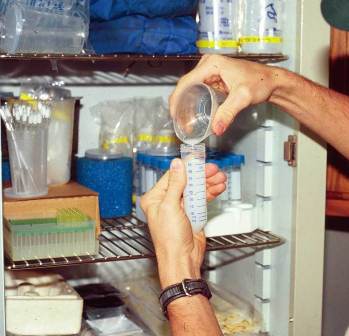 Seminal plasma makes a poor diluent for spermatozoa and this becomes evident when sperm are cooled in the presence of too much seminal plasma. It is therefore necessary to adequately dilute out the seminal plasma in semen with an appropriate extender to allow for maximum retention of sperm quality. It has been demonstrated that the minimum dilution rate for preserving sperm motility during storage at 5°C is 3 parts extender to 1 part semen. Higher dilution rates may be even better and our goal is to dilute semen a minimum of 3:1 while aiming for a final sperm concentration of 30 to 50 million total sperm per ml. In highly concentrated ejaculates this may mean diluting semen at rates in some instances as high as 11 or 12 to 1.
Seminal plasma makes a poor diluent for spermatozoa and this becomes evident when sperm are cooled in the presence of too much seminal plasma. It is therefore necessary to adequately dilute out the seminal plasma in semen with an appropriate extender to allow for maximum retention of sperm quality. It has been demonstrated that the minimum dilution rate for preserving sperm motility during storage at 5°C is 3 parts extender to 1 part semen. Higher dilution rates may be even better and our goal is to dilute semen a minimum of 3:1 while aiming for a final sperm concentration of 30 to 50 million total sperm per ml. In highly concentrated ejaculates this may mean diluting semen at rates in some instances as high as 11 or 12 to 1.
Insemination volumes greater than 60 ml are not desirable as much of the inseminated semen will run back out into the vaginal vault through an open estrus cervix. Therefore if the initial sperm concentration is low it may be necessary to concentrate the sperm through centrifugation prior to final extension and cooling. Semen can be concentrated by diluting 1:1 with cooling extender, loading 40 ml of extended semen into 50 ml conical bottom centrifuge tubes and centrifuging at 350-400x g for 10-12 minutes. Following centrifugation, the top 30 ml of supernatant containing extender and seminal plasma is aspirated and fresh extender is added to achieve the desired final concentration for cold storage. Using this technique approximately 75% of the sperm are recovered.
A higher recovery rate can be achieved using a cushioned centrifugation technique in which a small amount of a dense, inert preparation of iodixanol is layered under the extended semen at the bottom of the conical centrifuge tube and centrifugation is carried out at a higher g- force for a longer time (1000 x g for 20 – 30 minutes). The iodixanol provides a soft “cushion” for the sperm to concentrate against without damage due to tight packing seen against the bottom of a centrifuge tube without a cushion. Following centrifugation the majority of supernatant and iodixanol is removed and the concentrated semen is further diluted with fresh extender prior to cooling. Removal of most of the seminal plasma and concentrating the sperm with either of these techniques can greatly improve the retention of sperm motility during cooling for stallions that typically ejaculate semen with a low sperm concentration and in our laboratory is standard practice for any ejaculate with initial sperm concentration below 120 million per ml.
Storage and Transport Containers
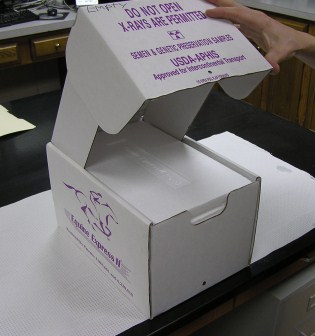 In North America most cooled semen is shipped by overnight Express mail service and therefore most mares are inseminated with semen that was collected 24-36 hours prior. It is also standard practice to ship two insemination doses for each mare if enough semen is available from that particular ejaculate. Some practitioners prefer to inseminate both doses when the semen arrives on the theory that the mare serves as a better storage container for the sperm than does any transport container while others will inseminate one dose upon arrival and hold the next dose to be inseminated the next day if the mare has not ovulated. This requires that the storage container be sufficiently insulated to maintain storage temperature of 4 – 8 °C for 48 hours. This is an important consideration when selecting a cooled semen storage container.
In North America most cooled semen is shipped by overnight Express mail service and therefore most mares are inseminated with semen that was collected 24-36 hours prior. It is also standard practice to ship two insemination doses for each mare if enough semen is available from that particular ejaculate. Some practitioners prefer to inseminate both doses when the semen arrives on the theory that the mare serves as a better storage container for the sperm than does any transport container while others will inseminate one dose upon arrival and hold the next dose to be inseminated the next day if the mare has not ovulated. This requires that the storage container be sufficiently insulated to maintain storage temperature of 4 – 8 °C for 48 hours. This is an important consideration when selecting a cooled semen storage container.
The Equitainer is considered the “gold standard” for cooling and shipping semen. The cooling rate achieved is optimum for retention of motility and the superior insulation and durability of the containers provides excellent maintenance of storage temperatures in extreme external environmental conditions. Most cooled semen in North America is shipped either in the Equitainer or in one of numerous available disposable Styrofoam shipping “boxes”. The boxes have two advantages over the Equitainer: 1) they are much less expensive and therefore are typically not shipped back to the stallion owner for re-use and 2) the insemination dose is loaded into a 60 ml syringe for cooling and shipment making it simpler for the inseminating veterinarian to unload and inseminate the mare. However, the control of the cooling rate and the maintenance of optimum storage temperatures may not be as good as the Equitainer in excessively hot or cold external temperatures.
Although shipping of cooled semen is relatively commonplace throughout the breeding industry today, there is still considerable variability in the quality of the semen received. It is expected that semen quality will vary depending upon the individual stallion, however, the influence from extrinsic factors should be minimized as much as possible - the goal of the stallion manager is to produce the best product possible.
You might also be interested in the following links:
Centrifugation for Cooled Transport
Should the US adopt stricter controls on cooled and frozen semen processing.





